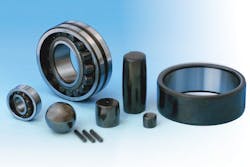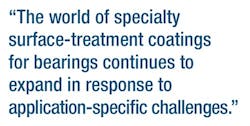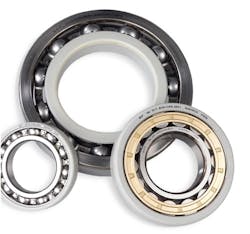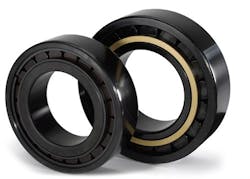How coatings can maximize rolling bearing performance
Industrial rotating machinery relies upon rolling bearings to reduce friction, power consumption and heat generation, while simultaneously supporting increasingly heavier applied loads at higher speeds with a higher degree of accuracy. Thousands of bearing types and styles offer a wide range of solutions suitable for applications across various industries.
But some application conditions will present particular challenges for rolling bearings, posing potential threats to optimized bearing performance and service life. Against this backdrop, various specialty coatings for bearings have been developed to address specific threats and, in the process, help upgrade bearing performance and machinery uptime.
Most bearing types can be coated (by the manufacturer) to serve in new applications or as “drop-in” replacements in existing machinery. In either case, the bearing’s dimensions remain unchanged. Depending on the formulation and purpose, bearing coatings ultimately can reduce damaging effects from vibration, improve performance under poor lubrication, help prevent adhesive wear (“smearing” damage), improve corrosion resistance and reduce friction.
Resisting wear
Bearings in service can be prone to wear for many reasons, whether due to poor lubrication conditions (associated with high temperatures and/or low lubricant viscosities), sudden variations in load or speed, standstill vibration and/or particle or liquid contaminants. All can lead to dramatically shorter bearing (and machinery) service life over time.
Providing an effective defense against premature bearing wear and other conditions, a patented wear-resistant carbon coating – only a few microns thick – can be applied to a bearing’s inside contact surfaces (rolling elements and/or raceways). The coated steel surfaces retain the toughness of the underlying material, while adopting the improved hardness, reduced friction properties and improved wear resistance of the carbon coating, which has an appearance and texture similar to silicon nitride (ceramic).
The most common execution involves coating the bearing rolling elements, while using the traditional steel raceways. During the running-in period, minute amounts of the coating material will transfer to the counter surfaces. This transfer bolsters friction reduction and improves resistance against wear and smearing damage.
Typical applications for an antiwear coating include industrial fans, gearboxes, paper machines and compressors, among many others. Such a coating can notably withstand a variety of severe operating conditions, including risks of smearing, insufficient lubrication film, sudden load variations, light loads, rapid speed changes, vibration and oscillations, and high operating temperature. The coating’s unique properties further advance high-speed capabilities and help tolerate contamination and/or poor lubrication conditions.
The anticipated outcomes for the coated bearing include increased reliability, extended service life and reduced chances of premature failure due to friction, wear, surface distress and fatigue.
Insulating against stray currents
When a stray AC or DC current in an electric motor or generator uses a bearing as its path to ground, electrical erosion of the bearing will likely develop. The most common causes of stray electric current leading to potential erosion are asymmetry in a motor’s magnetic circuit, unshielded power cables and/or fast switching pulse width modulated (PWM) frequency converters used in variable frequency drives (VFDs).
An assortment of bearings that integrates specialty coatings
Stray electric currents can harm bearings in at least three ways:
Excessive current erosion. When electric current passes through a bearing from one ring to the other via the rolling elements, it creates a process similar to electric arc welding, concentrating a high current density onto a small contact surface. As a result, the localized extreme temperature causes the bearing material to melt and weld, which creates micro-craters, pitting and changes in the grain structure of the bearing steel.
Current leakage erosion. When low-intensity stray electrical current passes through a bearing, the transfer of electrical energy causes damaging arcs inside the bearing. The secondary bearing damage can appear as flutes (“washboarding”) on the bearing raceways and/or rolling elements. The surface finish of the rolling elements can become dull with a frosted appearance. The extent of damage will depend on the type of bearing, bearing size, electrical regime, bearing load, speed and lubricant.
Lubricant degradation. High bearing temperatures caused by electric current can cause the additives in a lubricant to char or burn, resulting in the additives being consumed more quickly. The increased temperature also causes a rapid aging and oxidation of the lubricant. In the case of grease lubrication, the grease turns black and hard. This rapid breakdown dramatically reduces grease life and, in turn, bearing service life due to surface distress and surface fatigue (spalling).
Once bearing damage from electrical erosion has begun, increased noise levels, reduced effectiveness of the bearing lubricant, increased heat and excessive vibration can follow – all threatening to drastically decrease the operating potential of a bearing.
Bearings suffering from electrical erosion damage will operate with increased noise, vibration, heat generation and friction. The degraded lubricant will increase wear and surface distress inside the bearing and severely reduce bearing performance and service life.
One way to prevent damage from stray electric currents passing through a bearing is by introducing an insulating coating for the bearing “from the outside” as an alternative to using bearing materials with insulating properties, such as ceramics. This can be accomplished with a specialized protective coating on the bearing bore or outside diameter surface.
The coating’s thin aluminum oxide layer imparts an electrical insulating function into the bearing to form a superior barrier against electric arcing and the damaging erosion of bearing surfaces. The coating is applied (by the manufacturer) to the bearing bore or outside diameter, depending on the bearing’s size, using a plasma-spray technique. Upon application, the coating will not change a bearing’s overall dimensions and will not require modifications to equipment.
Adding value, bearings with this type of protective coating are further treated with a unique resin sealant to guard against humidity and water penetrating the coating and potentially reducing its effectiveness. This is especially relevant for applications situated in humid operating environments.
Expanding options
The world of specialty surface-treatment coatings for bearings continues to expand in response to application-specific challenges.
For example, black oxide applied to a bearing’s rings and/or rolling elements can promote higher reliability and performance in especially heavy-duty applications, such as industrial gearboxes. The treatment process – involving a chemical reaction at the surface layer of the bearing steel – is performed (by the manufacturer) in an alkaline aqueous salt solution at defined temperatures. Up to 15 different immersion steps create a thin, dark black surface layer of iron oxide FE3O4 delivering a performance upgrade for a broad range of bearing types and sizes.
This treatment can increase machinery uptime by enhancing resistance to corrosion and adhesive wear (smearing); improving performance in low-viscosity lubrication conditions; limiting risk of fretting, micro pitting and cracking; reducing potential damage from aggressive oil additives; and reducing the effects of friction and wear.
As another example, a zinc chromate coating for especially corrosive environments can serve as an alternative to stainless steel bearings. Ready-to-mount ball bearing units, often subjected to highly corrosive conditions, are prime candidates for this bearing coating treatment.
All these solutions illustrate that specialty coatings can be practical and cost-effective options to help maximize bearing operating performance and service life, even in tough conditions. Consulting with a qualified and experienced bearing manufacturer can help in identifying and choosing a coating best suited for the application challenge.
Matthew McCormack is an applications engineer at SKF USA Inc., based in Lansdale, Pennsylvania. He can be reached at [email protected] or at 267-436-6821.



